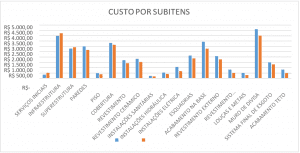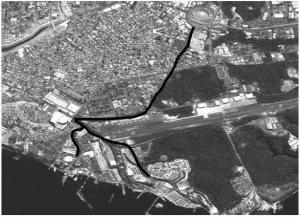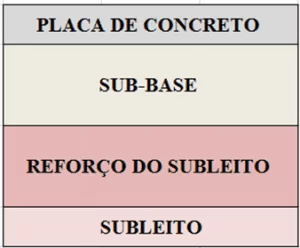SANTOS, Dario Pereira dos [1]
SANTOS, Dario Pereira dos. A brief Background on the theme: “Innovation in the public sector”. Multidisciplinary Core scientific journal of knowledge. 04 edition. 02 year, vol. 01. pp 69-80, July 2017. ISSN: 0959-2448
SUMMARY
The essence of this article is to reflect about the generation of innovations in the public sector as a way of ensuring greater efficiency in the provision of public services and to create value for individuals and for society. As the OECD (2017), is changing the way the Government operates for best results, encouraging the best use of public resources, the encouragement of more open societies and confident and strengthening justice and protection for citizens at all stages of life. The State exercises a central role in the economy intervened in economic relations and providing goods and services to meet the needs of citizens. In view of the increasing demand for a more responsible management of public resources, with greater transparency and social control, it is important that the topic “innovation in the public sector” is encouraged as a priority public policy within the governmental agenda. In this sense, the debate about innovative public policy presents itself as a model for creating instruments that enable improvements in organizations, systems and processes and to optimize the provision of goods and services to users.
Key words: innovation in the public sector, public policy, added value, efficiency, trust, protection.
Introduction
This work will be discussed the theme “innovation in the public sector” as a model to facilitate the implementation of changes in structures and processes with a view to the improvement of public services, in an effort in the search for innovative technologies and ideas for the public sector development. This is to overcome outdated structures and ways of thinking releasing hand of new ideas and technologies. According to the OECD (2017), the benefits of innovation are clear and the economic and social challenges that Governments face require new approaches to overcome pressing social problems in a rapidly changing environment. However, innovation is complex and challenging for Governments for a variety of reasons.
Governments around the world have faced persistent pressure in order to meet demands of an increasingly demanding society, which yearns for quick answers to complex problems and comprehensive, which mostly involve changes behavioral and whose solutions can lead to unexpected consequences. As the OECD (2017) Governments at the forefront of innovation are reinventing their operations to better meet these expectations, offering services more attuned to the life of its citizens from deep understanding of their needs, providing holistic solutions that optimize and continuously improve services in response to feedback received from the society.
The debate around the topic is growing throughout the world, in particular by the fact that we are living in a globalized world in which the information age has promoted changes in very short periods and an accelerated rate. Topping with the ambition of providing ways to positively impact the lives of citizens and to include them as partners in building a better future, replacing the traditional management in which public services are provided to the population by a new networked governance paradigm, in which those services are designed in conjunction with citizens. To ensure that services meet the needs of users is crucial that Government partnership with people who understand better the environment in which they are inserted.
This is a lot of potential with that innovation in the public sector is presented as another mechanism for collaboration in the solution of the challenges faced by Governments, cotidiamente that make use of the increasing shift of innovative tools to anticipate and understand the complexity and uncertainty of the societies and environments. For the OECD (2017), large data analysis the smart cities, social networks and drones since predictive algorithms to machine learning, technology is allowing Governments to monitor better the physical environment and daily concerns citizens. These tools can support Government decision-making and be used in new ways to interact with citizens, in particular by automatic detection of anomalies and prediction of potential crises that require government intervention.
Camões and Cavalcante (2017) show that among the main benefits of implementing innovative systems are improving the quality, effectiveness, efficiency, and economy, providing a greater involvement and satisfaction of users of the services public and an improvement in the response to the external environment.
In this sense, this article reveals appropriate to the extent that innovation has gained prominence as a fundamental issue for the public administration, with the potential to create solutions for the programs, policies and challenges of public service, contributing to the public administration can provide products and services with greater quality and efficiency. However, it is important to be aware that innovation is not a panacea, despite represent opportunities and conditions for good governance.
For preparation of the document using the bibliographical research and official sites, with extensive analysis of materials published in the literature, in addition to articles published in electronic sites.
Development
In Brazil the word “innovation” is still relatively little widespread, with few investments in innovative systems both in the public sector as in the private sector, so that the performance of the brazilian economy in terms of innovation is quite Modesto.
Schumpeter (1982) was one of the pioneers in the study of innovation. For him, technological innovation is associated with the idea of economic development, to break with previous standards, changing conditions and using new combinations to troubleshoot. He called the process of replacing old technologies with new ones like “creative destruction”.
To the Organization for Economic Cooperation and development (OECD) (2005), “innovation is the implementation of a product (good or service) new or significantly improved, or a process, or a new marketing method, or a new organisational method in business practices, in the Organization of the workplace or in external relations “and identifies four types of innovation:
1) product innovation: is the introduction of a new good or service or significantly improved with regard to its characteristics or uses.
2): process innovation is the implementation of a method of producing or distributing new or significantly improved. This includes significant changes in techniques, equipment and/or software.
3) marketing innovation is the implementation of a new marketing method with significant changes in the product design or in your package, your positioning in your promotion or price fixing.
4) organizational innovation: is the implementation of a new organizational method in the company’s business practices in your workplace organization or in its external relations.
Analyzing the definition presented, infers that innovation must be able to provide something new or improved to the entities, be disruptive or incremental, with added value to the product, process or method. You must pay attention, however, that not all innovation is necessarily desirable at all. Some are harmful to some groups or environments, as the news of clashes in several countries between taxi drivers and drivers of the UBER or increasing statistics of traffic accidents caused by drivers driving while access social networks by the smartphone, etc.
In general the debate around the theme emerges with insights from administrators and support public policies that see in elements of the innovative process improvement opportunities for the operation of the machine. Valuable ideas can also be incorporated based on experiences of civil society and the private sector, contributing to government authorities to review the role of public organizations.
According to Bekkers et al. (2011, apud 2016 Wedge), the relationship below provides the factors responsible for the intensification of new trend of innovation in public management:
- The existence of the so-called “wickedproblems”, which are comprehensive and contemporary problems answers difficult. Examples are: global warming, environmental disasters, population aging, terrorism, extreme poverty, increasing income inequality, etc.
- Traditional public and perennial problems are taking new contours and require new answers for additional advances are possible. Examples: education, health, urban mobility, security, international insertion, public expenditure, public administration etc.
- The society claims continuously, and often through blunt protests, the expansion of spaces for participation, what determines the strengthening of participatory democracy in parallel – or even replacing – representative.
- Public management models too technocratic and closed, both in the processes and goals and objectives, are ineffective for the growing dynamism, fluidity and severity of the multiple challenges of contemporary times.
This relationship in the current conjuncture of relevance WINS fiscal crisis and the need to improve the quality of public expenditure by which most of the countries are going through. As wedge (2016) is from these challenges comes to Governments the need to continually re-invent themselves and on a new basis. According to him, the inability to operate in diverse, complex environments and “disorganized” puts the State under constant pressure and it is precisely in this context in which traditional patterns and rules in force are put to the test that the institutions can – or must – innovate.
A valuable topic for the understanding of the innovative process is the study of the factors inducing innovation. They stimulate the initiative of innovative activities, responsible for motivating people in mobilizing efforts to achieve effective innovations. It is essential to understand them in order to be able to replicate them, to the extent possible, in the improvement of the management of organisations and innovation in solutions to common challenges.
Koch and Hauknes (2005, apud Brandão 2012) classified the inductors innovation as follows:
- Problem-oriented: innovations that are introduced to respond to one or more specific issues (demographic factors, ageing population, obesity, among others).
- No problem-oriented improvement: need for improvements in relation to a previous situation. For example, do things faster or more efficiently.
- Policy guideline: strategic changes in the public service require strong decisions from the top to the base. Can be based on ideology or in response to critical events and pressures. Can also be reflected through performance targets;
- Growth of a culture of review: A range of assessment practices has been developed over the years in the public sector, which has been used to evaluate the potential impacts of innovation and to promote a culture of organizational learning;
- Innovation support mechanisms: appropriate Allocation of resources (financial and other forms of support) to promote innovation and your implementation. Ally the allocation of resources is the provision of structures and systems to promote, encourage or disseminate innovation (suggestion boxes, stakeholder feedback mechanisms, network activities, encouragement of alternative thoughts and good monitoring practices within and outside the Organization);
- Capacity for innovation: teams with high levels of professional experience, creative and with ability to solve problems, associated with the desire to contribute to the improvement of the well-being and quality of life of citizens;
- Competitive: use of performance targets can encourage the use of innovative approaches;
- Technological factors: Introduction or availability of a new technology may provide opportunities for other types of innovation (organizational, process, service, system of interaction, among others).
In addition, we can mention other activators of the innovation process, such as when we experience shortage or frames when missions are set out, goals are agreed upon, in scenarios of urgency in meeting demands or when opportunities if feature depending on the circumstances existing at the time.
In summary, the success of innovation systems depends on the deep commitment of all and that innovation is inserted as a strategy of the organization. Organizations that act in this way will be continually at the forefront of innovation, always attentive to trends and opportunities. It is important to note that the knowledge does not necessarily need to be included within the Organization, and may be obtained outside of the Organization, by means of external experts, when the entity alone feel unable to provide them.
Another important point within the innovation process is the study of barriers to innovation, interpreted as any factors capable of influencing negatively the innovative process. Develop innovation means tackling political, organizational and cultural factors, lack of encouragement, financial support, the low capacity of managers and employees and risk aversion in government bureaucracies. These bureaucracies, the hierarchy, combined with the lack of transparency and collaborative participation impact negatively the innovative process by restricting it to few inside the Government. The attachment too rules discourages the creation of new products and services, repressing any creative idea. Public officials are penalized when wrong and are not rewarded for any successful risks.
Bommert (2010) cites several obstacles to innovation, highlighting the culture of risk aversion, presence of bureaucratic Governments with tiered structures and closed and lack of financing, among others. It is important to note that even simple innovations require some level of funding so that they can cross the path from idea to reality. Brandão (2012) points out that one reason for the aversion to risk is the fear of being found guilty publicly for the failure or the image that the Government acts of irresponsible way with public money. In other words, the difficulty to predict the success of innovations raises apprehension in allocating resources in these activities.
Finally, the literature in general points as main barriers to innovation in the public sector excess rules, uncertainty with respect to the results and low integration between departments. The environment in which the Governments discourage to face risks. The media, for example, usually extol more failures than the successes of the public service. The excess of formalism promotes predictability in an aversion to any possibility of risk, repelling, therefore, every initiative of creativity.
For the OECD (2017), innovate means dealing with uncertainty, to accept that sometimes the experiments do not work as expected and that many innovative efforts will fail, but that should not discourage governments from trying out new opportunities, means that should do it consciously, evaluating the risks and developing strategies to manage them. To test and validate new ideas and solutions in a manageable scale before to spread and expand successful experiments, Governments can persevere in exploration of new solutions, minimizing their costs.
A contemporary debate on innovation refers to the open innovation in the public sector, which stimulates the integration of external actors as part of the innovative process, recognizing that good ideas can be expressed outside of Government and redefining this way, the boundaries between Government and citizens. The intention is to use the knowledge and experience of the society with the desire to improve government services and meet the needs of a world in a rush processing. Meets as the openness and collaborative principles in favour of creativity at the same time promoting trust and inclusion in society, strengthening thus the democratic environment. According to the OECD (2017), some countries are using technological tools to catalyse innovation, connecting innovative citizens who wish to collaborate with the Government to find new ways to strengthen government programs.
Another trend in the next generation of supply of public goods and services. For the OECD (2017), traditional approaches to provide services are coming to an end. Innovative Governments no longer require more citizens know the organisation chart of the Government to obtain services, but, instead, draw services focusing on users viewed holistically as citizens and recognise that each individual has wishes and specific needs. In Warsaw, in Poland, civil servants are citizen-focused consulting blind residents in order to deploy a network of beacons to allow people with visual disabilities to move around the city and become independent.
Finally, reflecting the trend of innovation in the public sector, a current discussion that shows expanding Governments is the creation of laboratories of innovation. These labs are emerging as a new way to meet the challenges of the public sector as opposed to traditional approaches and departamentalizadas of public policy. The purpose aims to reunite people with the aim of finding solutions to complex problems, allowing experimentation with various possibilities to determine which approaches work in meeting the demands.
Conclusion
This article sought, in tight synthesis, report the current context in which the innovative processes in the governmental sector around the world, in addition to presenting the main barriers, inductors and international trends related to the theme. The concern with the improvement of public services and expenses tied to the contemporary challenges and growing demands of an increasingly demanding society and that seeks greater involvement in the preparation, implementation and control of public policies establish the State the urgency to innovate, and in democratic and participatory basis.
There are many challenges and barriers to be overcome to define and implement policies directed to the implementation of innovation systems. The lack of understanding of the benefits of innovative processes have prevented Governments from implementing Intelligent public policies that exceed the challenges and the opportunities made available to internalizem of the brazilian economy and society. The literature leaves no doubt about the immeasurable benefits from innovation and the trend is that more and more countries will embrace innovation and technology as tools to address the growing challenges and the expectations of citizens.
There is an urgent need for a generation of innovative leaders who come to stimulate the culture of innovation within the Governments and thus contributes to leverage the debate and strengthening around this topic that is strategic for the improvement of the management public. The moment favours this debate given the convergence between the innovation agenda and the main current trends in public administration, as the electronic government (e-government) the Government open, the demands for more transparency, accountability (accountability), active participation of citizens, acting on networks and partnerships with State, social actors and the private sector.
To conclude, I highlight a comment from Mazuccato (2014) according to which the innovation going on, increasingly, to be understood as both an opportunity and a condition to which Governments give effective responses to the needs of contemporary times. To the author, “there’s a prophecy author achievable. The talk of the State as irrelevant, boring, we actually create public organizations like that. So, what we really have to do is build State organizations of entrepreneurs. ”
REFERENCES
BARNETT, s. (2012). Inductors and barriers to innovation in management in public organizations of Brazilian federal Government: analysis of the perception of leaders. Thesis (master’s thesis)-Universidade de Brasília, Brazil.
BARNETT, s. and BRUNO-FARIA (2013). Innovation in the public sector: analysis of scientific literature in national and international journals of the administration area “, Journal of public administration.
CUNHA B.Q. (2016). An analysis of the construction of the innovation agenda in the public sector from precursor international experiences. IX Congress CONSAD Public Management – Ulysses Guimarães Convention Center, Brasilia/DF.
CHAN, p. and CAMÕES, m. (2015). XX Congreso Internacional del CLAD on la Reforma del Estado y de la Administración Pública, Lima, Perú.
CHAN, p. and CAMÕES, m. (2017). Public Innovation in Brazil: an overview of its types, results and drivers. Available at http://ipea.gov.br/agencia/images/stories/PDFs/TDs/ingles/dp 222.pdf. Accessed on 9 may 2017.
OECD (2005). Oslo Manual: Guidelines for Collecting and Interpreting Innovation Data, 3rd Edition.
OECD (2015). The Innovation Imperative in the Public Sector: Setting an Agenda for Action. OECD Publishing, Paris.
OECD (2017). Embracing Innovation in Government: Global Trends. OECD Publishing, Paris.
SCHUMPETER, j. (1982). The theory of economic development: an inquiry into profits, capital, credit, interest and the business cycle. São Paulo: April.
MAZZUCATO, m. (2011). The Entrepreneurial State. Demos, United Kingdom.
Mazzucato, m. (2014), ‘ mission-oriented approach to building the entrepreneurial state ‘, the ‘ think piece ‘ for the Innovative UK. Available at: http://marianamazzucato.com/wp-content/uploads/2014/11/MAZZUCATO-INNOVATE-UK.pdf
CASSIOLATO, J.E. (1992). The role of user-producer relations in innovation and diffusion of new technologies: lessons from Brazil. Thesis (doctoral) — University of Sussex, England.
In THIS (2011). Innovation in Public Sector Organisations: the pilot survey for measuring innovation across the public sector.
Nordic Innovation Centre (2011). Measuring Public Innovation in the Nordic Countries, The Danish Centre for Studies in Research and Research Policy (CFA).
BOMMERT. B. (2010). Collaborative innovation in the public service. International Public Management Review.
BEKKERS, v., Edelenbos, j. eSteijn, b. (2011). Linking Innovation to the Public Sector: Contexts, Concepts and Challenges, in Bekkers, v., Edelenbos, j. and Steijn, b. (eds) “Innovation in the Public Sector – linking capacity and leadership”, Palgrave Macmillan, cap. 1.
KOCH, P.; HAUKNES, j. (2005). On innovation in the public sector. Oslo: Publin Report, n. D20.
WALKER, R.M. (2014). ‘ Internal and External Antecedents of Process Innovation: the Review and Extension ‘, Public Management Review.
VIGODA-GADOT ERAN, et al. (2008). Public sector innovation for Europe: a multinational eight-country exploration of citizen’s perspectives. Public Administration Journal
[1] Bachelor’s degree in Civil Engineering from the Federal University of Minas Gerais-UFMG.
















